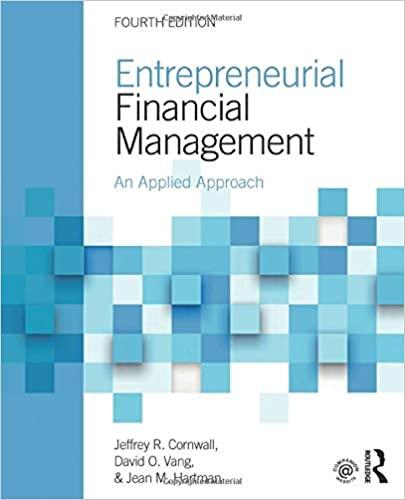Question
FSA Memo for Principles II Not acceptable Acceptable Outstanding Calculated ratios-10% -Misses one or more ratios -Made 3 or more calculation errors -Calculated all necessary
FSA Memo for Principles II Not acceptable Acceptable Outstanding Calculated ratios-10% -Misses one or more ratios -Made 3 or more calculation errors -Calculated all necessary ratios -Made 1 or 2 minor calculation errors -Calculated all necessary ratios -Made no calculation errors Explained significance of ratios-30% --Did not use the ratios to make a decision or -Did not suggest a decision or -Suggested a decision thats not supported by the ratios -Suggested a decision and supported it by referring only in a general way to the ratios or -Makes little or no comparison to the ratios of previous years or of industry competitors -Suggested a decision and supported it by referring precisely to specific aspects of the ratios and -Makes a specific and detailed comparison to the ratios of previous years or of industry competitors -Relate ratio results to each other (address 4 key aspects of ratios from instructions) Length of discussion-10% -Makes a one-sentence recommendation with no discussion -Word count <500 -writes a few sentences describing the decision, but does not use ratios to support it. -word count -write well-developed paper that explains decision with specific reference>500 Addressed need of audience (manager of your company)-30% -Does not discuss the companys short-term and long-term ability to pay bills or Fails to discuss any of the following: - the companys profitability or - management of the company or --market perceptions of the company or --liquidity -Only generally discusses the companys short-term and long-term ability to pay bills\Only generally discusses one of the following -the companys profitability or - management of the company or - market perceptions of the company or --liquidity -Thoroughly discusses the companys short-term and long-term ability to pay bills (liquidity) -Thoroughly discusses the companys profitability and -Thoroughly discusses management of the company and --Thoroughly discusses market perceptions of the company Presented self professionally-20% -Poor editing (4 or more minor errors or major errors that interfere with meaning) - ratios or discussion are presented in an organized way -Reasonable editing ( 1 to 3 minor errors that do not interfere with meaning) -Ratios are organized -Sections of the prose memo are organized -Typed -Well edited (no major errors in spelling, punctuation or grammar) -Ratios are labelled by type Instructions: Discuss 4 key aspects of ratios: Did the ratio go up or go down? Is that good or bad? Why or Why Not? What does that tell me about.(solvency, liquidity, growth, etc.) Instructions: Comparative income statements and balance sheets for Blackwater Falls Company follow for 2017 and 2016. Blackwater Falls Company Comparative Income Statements December 31, 2017 and 2016 2017 2016 Sales $11,788,000 $11,252,000 Cost of goods sold $6,625,000 $6,405,000 Gross profit $5,163,000 $4,847,000 Selling and administrative expenses $3,576,000 $3,374,000 Operating income $1,587,000 $1,473,000 Other expenses (revenues) Interest revenue $(104,000) $(89,000) Interest expense $87,000 $80,000 Total other expenses (revenues) $(17,000) $(9,000) Income before income taxes $1,604,000 $1,482,000 Income taxes $722,000 $671,000 Net Income $882,000 $811,000 Blackwater Falls Company Comparative Balance Sheets For Years Ended December 31, 2017 and 2016 2017 2016 Assets Cash $252,000 $269,000 Marketable securities $447,000 $213,000 Accoutns receivable $977,000 $1,056,000 Inventory $1,611,000 $1,630,000 Prepaid expenses $135,000 $126,000 Total current assets $3,422,000 $3,294,000 Investments and other assets $785,000 $614,000 Property, plant, and equipment, net $2,829,000 $2,692,000 Trademarks and other intangibles $273,000 $291,000 Total assets $7,309,000 $6,891,000 Liabilities and stockholders' equity Notes payable $189,000 $185,000 Current maturities of long-term debt $20,000 $25,000 Accounts payable and accrued expenses $1,832,000 $1,943,000 Total current liabilities $2,041,000 $2,153,000 Long-term debt $666,000 $549,000 Total liabilities $2,707,000 $2,702,000 Common stock, $10 par value $135,000 $135,000 Additional paid-in capital $238,000 $236,000 Retained earnings $4,229,000 $3,818,000 Total stockholders' equity $4,602,000 $4,189,000 Total liabilities and stockholders' equity $7,309,000 $6,891,000 Additional Company Information Market value of common stock: $80 in 2017 and $70 in 2016 Credit terms: n/30 days 2016 Days Sales Receivable: 35 days 2016 Inventory Turnover: 3.6 times Industry Average for Inventory Turnover: 4 times Bank requires a Times-Interest Earned Ratio of 15 Industry Average for ROA: 15%
Step by Step Solution
There are 3 Steps involved in it
Step: 1

Get Instant Access to Expert-Tailored Solutions
See step-by-step solutions with expert insights and AI powered tools for academic success
Step: 2

Step: 3

Ace Your Homework with AI
Get the answers you need in no time with our AI-driven, step-by-step assistance
Get Started


